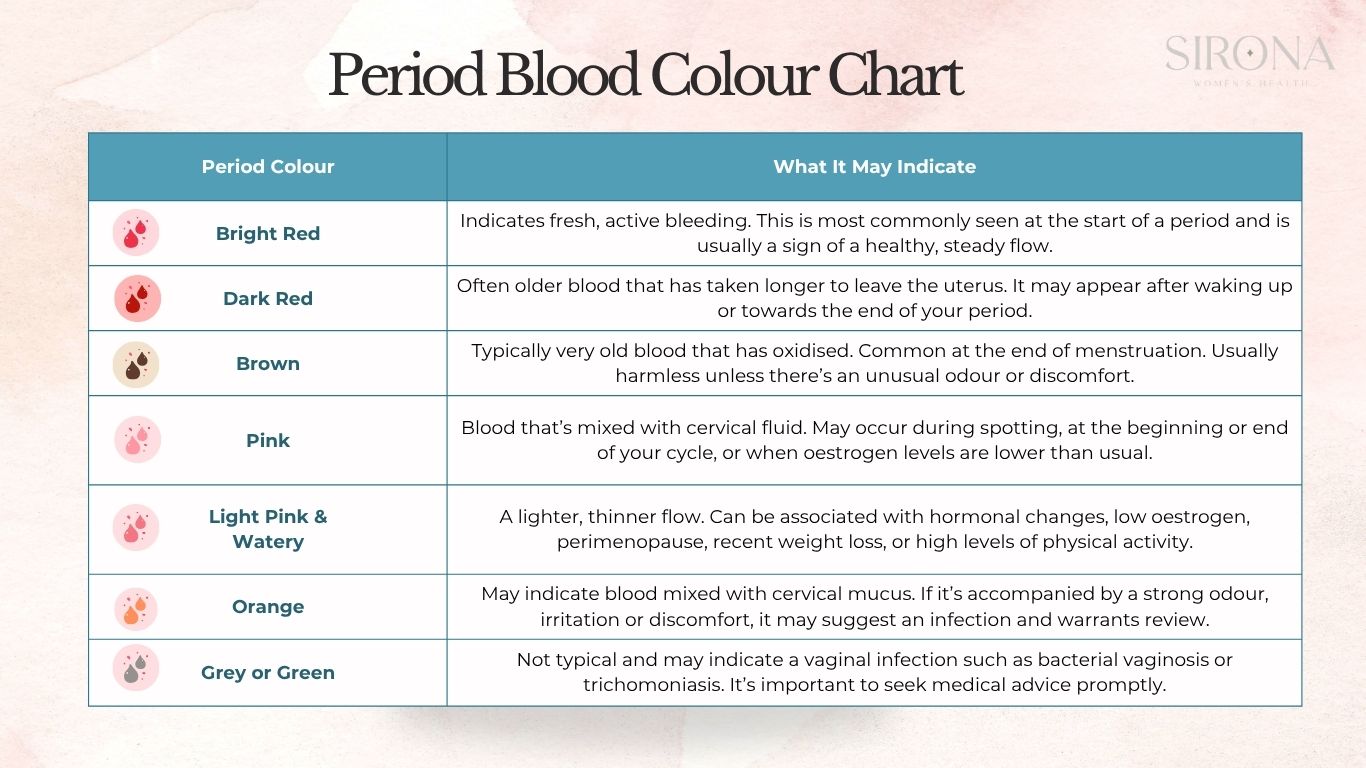Noticing changes in the colour of your period blood is common and often a normal part of your menstrual cycle. In most cases, these colour variations are harmless and simply reflect natural hormonal changes, the speed of blood flow, or how long the blood has been exposed to oxygen.
However, there are times when colour changes may point to an underlying issue. This guide outlines what different period blood colours may mean, what’s considered typical, and when it may be time to speak with your GP.
Why Menstrual Blood Colour Changes
Menstrual blood is a mix of blood, uterine lining, and cervical fluid. Its appearance can vary from person to person, and from one cycle to the next. Factors like hormone levels, flow rate, and timing within your cycle can all influence its colour.
Period Blood Colour and What They Mean

Bright Red Menstrual Blood
Bright red blood is typically a sign of fresh, active bleeding. It usually appears at the beginning of your period when your body is shedding the uterine lining at a steady rate. This type of flow is common during the heaviest days of menstruation.
It’s generally considered healthy and normal. However, if you’re seeing bright red blood outside of your usual period such as between cycles, it may be worth discussing with your GP, as it could be related to spotting, hormonal imbalances, or other conditions.
Dark Red or Brown Blood
Brown or dark red period blood is usually older blood that’s taken more time to pass through the uterus. This often happens when your flow is light such as at the beginning or end of your period. As the blood is exposed to oxygen, it naturally darkens, which is generally nothing to worry about.
You might also notice brown spotting after a missed period or in early pregnancy. However, if it’s happening often outside your usual cycle or comes with unusual discharge or cramping, it’s best to check in with your doctor.
Pink Period Blood
Many people wonder, “Why is my period blood pink?” or “My period blood is light pink and watery should I worry?”
Pink blood is often a sign that menstrual blood has mixed with cervical fluid. This can happen when your flow is light, such as during the start or end of your period, or with light spotting.
If your period is consistently pink, it may point to low oestrogen levels possibly linked to stress, hormonal contraception, or nutritional gaps. It can also appear during ovulation spotting or early pregnancy. If this is a new or recurring pattern, it’s worth discussing with your GP.
Light Pink and Watery Blood
If your period blood is light pink and watery, it might suggest a thin menstrual blood flow, which can be linked to hormonal imbalances or low oestrogen production. This can occur in people who engage in intense physical activity, experience high levels of stress, or have a very low body weight or body fat percentage.
It’s also common in people approaching perimenopause or those with certain underlying health conditions like anaemia or thyroid disorders. While a light, watery period isn’t always a red flag, consistent changes in flow and colour should be monitored.
Orange Period Blood
Orange blood can appear when red menstrual blood mixes with cervical fluids. If there are no other symptoms, this may not be a concern. However, if orange blood is accompanied by unpleasant odour, itching, or irritation, it may indicate an infection such as bacterial vaginosis or trichomoniasis.
It’s important to monitor how long it lasts and whether any other signs of discomfort occur.
Gray or Green Period Blood
Gray or greenish menstrual blood is not normal and can be a sign of a vaginal infection. In particular, grey discharge often indicates bacterial vaginosis. Other symptoms might include itching, strong odour, discomfort, or fever.
If you notice this type of discharge, it’s best to see your GP as soon as possible to rule out infection and start treatment if necessary.
Thin Menstrual Blood: Is It Normal?
Thin menstrual blood that looks more watery than usual can be a result of light flow or low hormone levels. This can happen during lighter periods or as part of hormonal shifts, such as during perimenopause or due to stress, poor diet, or significant weight loss.
In some cases, thin blood may also signal a lack of sufficient endometrial lining buildup, which could affect fertility. If you notice that your period is consistently thinner and accompanied by other symptoms such as fatigue, hair loss, or irregular periods, it may be a sign of underlying period concerns, it’s worth checking in with your GP.
When Should You Be Concerned About Period Blood Colour?
Most of the time, colour changes are part of your body’s natural rhythm. But there are times when it’s worth getting things checked. Reach out to your GP if you notice:
- Gray or green discharge
- Unusually watery, thin, or light pink blood over multiple cycles
- Painful periods with clotting larger than 2.5 cm
- Spotting between periods
- Changes in your cycle that persist for more than two months
- A strong or unusual vaginal odour
- Bleeding that lasts longer than 7 days
These could be signs of hormonal disorders, infections, fibroids, polyps, or other reproductive health conditions that may need treatment.
What Does It Mean if My Period Starts Brown and Then Turns Red?
Brown blood usually indicates older menstrual blood that has oxidized and taken longer to leave the uterus. This is common at the very beginning or end of your period. As your menstrual flow increases, you’ll notice brighter red blood, which is fresher and shows active bleeding. This pattern is normal and usually not a cause for concern.
Why Is My Period Blood Stringy or Clotted?
It’s not unusual to pass small clots or stringy bits of tissue during heavy days. Clots smaller than 2.5 cm are generally normal and form when the uterus sheds faster than the body can break down the tissue. If clots are large or frequent, or if your flow is very heavy, it’s worth speaking to your doctor to check for conditions like fibroids or hormonal imbalances.
Can Stress or Diet Affect My Period Blood Colour?
Yes. High stress levels, significant weight loss, very low body fat percentage, or restrictive diets can lower estrogen levels. This hormonal change can cause your period blood to be lighter, thinner, or pink-tinged. These factors can also impact your menstrual cycle regularity and flow intensity.
Is It Normal for My Period to Be Light Some Months and Heavy Others?
Fluctuations in period heaviness are common and can be influenced by stress, travel, illness, medication changes, or natural hormonal shifts. However, if you experience sudden, extreme changes in flow or duration that last more than two consecutive cycles, or if you have bleeding that lasts longer than 7 days, it’s best to speak with your GP to check for any underlying health concerns.
Can Birth Control Change the Colour of Your Period?
Yes. Hormonal contraceptives including pills, patches, injections, and hormonal IUDs, can alter your menstrual bleeding pattern. This often results in lighter bleeding, spotting, or changes in blood colour such as pink or brown spotting between periods. These changes are usually harmless but should be discussed with your healthcare provider if they cause concern.
Supporting Your Menstrual Health at Sirona Women’s Health
Your menstrual cycle can offer helpful insights into your overall wellbeing. While colour changes like red, brown, or pink are often normal, it’s important to stay aware of what’s typical for your body and seek advice when something doesn’t feel right.
At Sirona Women’s Health Clinic in Brisbane, our all-female GP team is here to support you through all stages of your reproductive health. Whether you’re experiencing irregular periods, heavy bleeding, or conditions like PCOS or endometriosis, we offer personalised, compassionate care to help you feel your best.
Disclaimer: This information is intended for educational purposes and should not replace professional medical advice. Please speak with your doctor about your individual symptoms or concerns.
